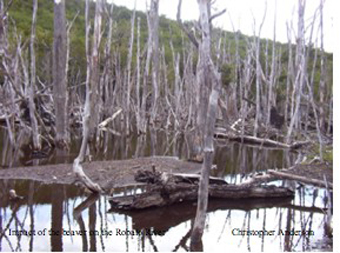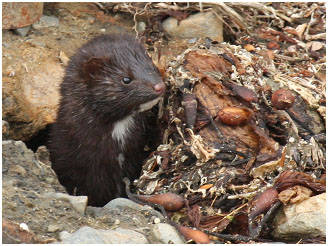 An important aspect of global ecological change involves the loss and homogenization
of biological diversity, driven in large part by invasion of introduced species. At
the southern tip of the Americas, encompassing nearly 5 million hectares of islands,
fjords, lakes, glaciers, peat bogs and Nothofagus-dominated forests, the Cape Horn
Biosphere Reserve (CHBR) hosts one of the world's most pristine remaining wilderness
areas. Its remoteness and singularity, however, are presently threatened by forces
of global connectivity that are leading to rapid biological homogenization across
distant territories. While the CHBR is in many ways considered a highly pristine wilderness
area, it is also replete with introduced and often invasive species.
An important aspect of global ecological change involves the loss and homogenization
of biological diversity, driven in large part by invasion of introduced species. At
the southern tip of the Americas, encompassing nearly 5 million hectares of islands,
fjords, lakes, glaciers, peat bogs and Nothofagus-dominated forests, the Cape Horn
Biosphere Reserve (CHBR) hosts one of the world's most pristine remaining wilderness
areas. Its remoteness and singularity, however, are presently threatened by forces
of global connectivity that are leading to rapid biological homogenization across
distant territories. While the CHBR is in many ways considered a highly pristine wilderness
area, it is also replete with introduced and often invasive species.
A special emphasis of research in the archipelago has taken into account this particular component of global ecological change. The ecological and ethical implications of invasion have been especially studied for two harmful species: the North American beaver (Castor canadensis) and the American mink (Neovison vison). Together with government agencies, our scientists are also working on the application of effective control programs, which beginning in 2006 have taken on a binational strategy between Chile and Argentina.
The American Mink (Neovison vison) as an invasive species
Another species that invaded the Cape Horn region recently is the American mink, which has been recognized by our scientists as a key predator on ground nesting birds and other terrestrial and marine species. For instance, by tracking the signal of a radio-marked Magellanic woodpecker we recently found out that our bird was preyed by a mink. Based on this observation, we can hypothesize that minks could potentially eliminate the woodpecker population of Navarino Island. Our long-term observations indicate that this is already going on with other birds.
